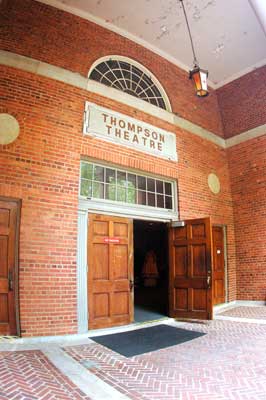To be or not to be.
With inflation of building costs and dissent over the schematics of a multimillion dollar project — that is the question currently facing members of University Theatre and other organizations concerning the renovation of the 81-year-old Frank Thompson building.
Multiple University entities, including University Theatre and the Crafts Center, have vested interests in the project that is currently scheduled to begin next August.
Despite nagging concerns, students and administration said they were anxious for the renovations to begin.
“Thompson and the Craft Center are such great resources for students to escape stresses of class and a great way to use energy to make something productive,” Heather Inman, a business education sophomore and desk attendant at the Crafts Center, said. “I think [the renovation] will be a great thing and it is necessary to keep the building alive.”
Inman, whose father used the Thompson facilities to do woodwork when she was young, said despite the lack of natural light and poor aesthetics, Thompson holds a sentimental place in her heart.
“It’s kind of rundown, but it feels homey,” she said. “Other studios I have visited are a lot more stiff.”
And if building plans proposed by Jenkins-Peer, an architectural firm out of Charlotte commissioned for the job, hold true to form and schedule, Inman may be, once again, out of her comfort zone.
“With the renovations, we will have a separate glazing room, which will be healthier to keep chemicals away, and we will have a little more room for spacing and studios,” Inman said. “But, now we will have to set up temporary locations for students – however, we can’t guarantee that, so people may have to find other places to work on crafts.”
Terri Janney, associate director for University Theatre, said the same holds true for the theater program, as well as the art studies major housed under the College of Humanities and Social Sciences.
“We’re just anxious for [renovations] to begin,” Janney said. “It will be a struggle to keep the program going while we are without Thompson. We hope the University will find a space where we can rehearse so our program can continue.”
The renovations, partially funded by a reoccurring $30 student fee that begins in the fall semester, include the gutting of the historic building, the construction of a two theaters with a total estimated occupancy of 300 people, enhancing aesthetics and adding a wing comprised of two floors and approximately 14,000 square feet.
Janney said plans to open up the side walls would reveal windows that have been covered for years, resulting in mood-enhancing natural light. Janney said she also hopes for an improved front door.
“We are hoping to enclose the porch in glass and have a box office on the outside,” she said. “It will look very elegant.”
Drexel Heard, a sophomore in communication and political science, voted for the student fee last year as a student senator and is feeling the pangs of the procedure as a member of University Theatre.
“Once Thompson closes down, the classrooms are closing down. As far as rehearsal space, that is gone as well,” Heard said. “It’s going to be tough.”
Associate Vice Chancellor for Student Affairs Alex Miller said the University, as with any project, was working on setting aside space for the theatre program to use.
“Anytime a building is renovated they have to identify swing space,” Miller said. “The University architecture office is helping in finding that space.”
Miller said one proposal was the use of modular units, such as those in Riddick Lot currently housing College of Design classrooms.
While Miller cannot assuage “swing space” fears, he said controversy over whether a change to the Thompson building would occur could rest. Unlike privately funded projects that sit on “backburners” like a planned golf course on Centennial Campus, Miller said the student support makes the theater renovation a priority.
“Because students have committed money already, the project is going to happen,” he said. “There is going to be a major renovation and it will begin at the end of next summer.”
Miller said that aside from the $10.5 million guaranteed from the student fees, the University has committed to raising an additional $5 million from private sources. He said $1.2 million has already been raised in the past year.
“Our challenge now is to get more of those major donors to commit those gifts,” he said.
Miller said the project is expected to take 18 months to complete, ending in January of 2009.
A meeting today between Jenkins-Peer and the University architecture office will work toward the finalization of the massing and exterior of the planned renovations, according to Miller.








